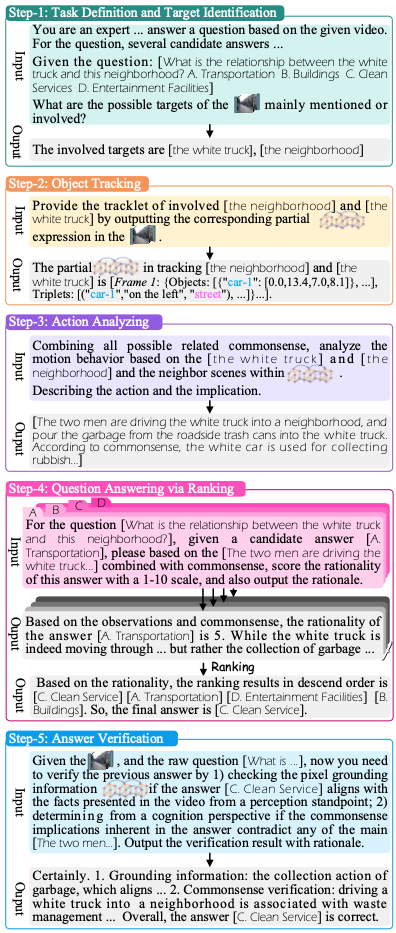Abstract
- Suggests MotionEpic, a model that integrates STSG to video
- Suggests VoT(Video of Thought) framework
Motivation

video에 대한 reasoning을 수행하기 위해서는 두 종류의 ability가 필요하다.
- fine-grained perceptive pixel understanding of the video movement
- cognitive ability allowing reasonable explanation and causal imagination
실제로 사람이 video에 대해서 reasoning을 할 때에는 multi-hop으로 추론하므로 이를 모방하는 것이 필요하다고 짐작하기는 어렵지 않다. intuitive하게 따라서, CoT와 비슷한 형태의 formatting을 통해 문제를 subproblem으로 divide하여 해결하도록 만들었다.
또한 여기에 STSG(SpatioTemporal Scene Graph) representation을 intergrate하여 이를 활용할 수 있도록 만들었다. 전체 architecture는 MotionEpic으로 명명되었다.
VoT는 다음과 같은 procedure로 구현된다:
- VoT identifies the possible target(s) involved in the question to observe
- The system grounds the temporal tracklet(s)
- VoT interprets the target object's trajectory and interactions
- LLM examines each optional answer
- VoT performs verification for the answer
MotionEpic

Overview
LLM으로는 Vicuan-7B-1.5v를 사용하고, video input으로는 ViT-L/14 encoder와 Q-Former projector를 사용한다.
STSG를 위해서는 Graph Transformer를 수정하여 사용한다.
Integrating STSG Representation
STSG definition을 수정하여 사용한다. 먼저 video에서 uniform하게 frame을 sample한다. $k$th frame의 SG를 $G_k = (V_k ; E_k)$라고 하면, 각각의 vertex는 다음과 같이 표현된다:
$$ v_{k,i}=(c_i,f_i,b_i)_k$$
이때 c는 category label, f는 neural representation, b는 $(x,y,w,h)$로 2D coordinate을 의미한다.
일반적인 SG와 같이 각 subject와 object는 predicate로 연결된다. 여기에 이전 frame의 동일한 object에서 다음 frame의 object로 'tracking' edge가 temporality를 위해 추가된다.

Fig.3 에서 STSG representation의 예를 볼 수 있다.
Fine-grained Video-Scene Grounding-aware Tuning
실제 inference 과정에서는 STSG가 들어오길 기대하기 어려워 STSG-free inference가 수행될 수 있어야 한다. 따라서 MotionEpic이 자동으로 STSG를 parse할 수 있도록 만든다. 이때의 objectives는 다음과 같다:
- Enhancing coarse-grained correspondence:
- $\mathcal{L_1}$: predicting if the overall input video and STSG are paired.
- $\mathcal{L_2}$: generating the whole STSG of the video
- Enhancing fine-graiend correspondence:
- $\mathcal{L_3}$: video and action description에 대해 object tracklet 출력
- $\mathcal{L_4}$: video and key object(s)에 대해 temporal action description 출력
- $\mathcal{L_5}$: video와 특정 frame bbox에 대해 object label 출력
video encoder는 frozen되었고, LLM은 LoRA finetuning했으며 video projector와 STSG encoder는 train되었다.
-> STSG는 정확히 어떻게 train했는지?
Video-of-Thought Reasoning Framework

VoT는 다음과 같이 subproblem들을 구성한다:
- Task Definition and Target Identification
MotionEpic은 text prompt, task definition, format, raw question과 raw video를 입력받는다.
Given the question [Question], what are the possible targets of the [Video] mainly mentioned or involved?
- Object Tracking
STSG를 사용하여 temporal grounding을 한다. 이때 STSG는 concise하여 MLLM의 hallucination issue를 줄이는 역할을 한다.
Provide the tracklet of involved [Target] by outputting the corresponding partial [STSG] expression.MotionEpic은 이미 object와 STSG를 grounding할 수 있으므로, [Target Tracklet]을 yield한다.
- Action Analyzing
STSG와 pixel observation, 그리고 commonsense knowledge까지 결합해서 in-depth understanding을 하도록 prompting한다.
Combining all possible related commonsense, analyze the motion behavior based on the [Target Tracklet] and the neighbor scene within [STSG]. Describing the action observations and implications.이를 통해 target에 대한 자세한 description인 [Observation and Implication] 을 얻는다.
- Question Answering via Ranking
이제 original question에 대해서 대답한다. multiple choise QA problem으로 문제를 formatting한 뒤, 각각의 answer에 대해 likelihood를 1 to 10의 값으로 평가하도록 한다.
For the question [Question], given a candidate answer [Answer], please based on the action's [Observation and Implication] combined with commonsense, score the rationality of this answer with a 1-10 scale, and also output the rationale.여기서 얻은 option들의 rank에 따라서 optimal answer인 [Answer]를 만든다.
- Answer Verification
정답이 올바른지 check하는데, 이때 이미 얻은 정답이 correct하다고 가정하고 두 aspect에 대해 평가한다:
- pixel grounding information이 align되는지
- commonsnse와 contradict하는지
Given the [Video], and the raw question [Question], now you need to verify the previous answer by
1) checking the pixel grounding information if the answer [Answer] aligns with the facts presented in teh video from a prrception standpoint;
2) determining from a cognitive perspective if the commonsense implications inherent in the answer contradict any of the main [Observations] inferred in the 3-rd reasoning step.
Output the verification result with rationale.만약 inconsistency가 발견되면 4-th step으로 돌아가 다시 answer를 select한다.
Experiments
Implementations
LLM으로 Vicuna-7B-v1.5, video encoder로 ViT-L/14와 projector로 Q-former를 사용했다. Graph Transformer encoding STSG는 768d hidden size의 6 layer architecture로 사용되었다. object neural representation은 CLIP을 사용했다.
video는 8fps로 sampling되었다.
Results




Discussion
References
[1] Fei, Hao, et al. "Video-of-Thought: Step-by-Step Video Reasoning from Perception to Cognition." Proceedings of the International Conference on Machine Learning (ICML), 2024.
Footnotes
'DL·ML > Paper' 카테고리의 다른 글
| InstructGPT / RLHF (NeurIPS 2022) (1) | 2024.08.21 |
|---|---|
| PPO (Policy Proximal Optimization) (1) | 2024.08.20 |
| VPD (CVPR 2024 Oral, VLM) (0) | 2024.08.05 |
| InternVideo2 (VFM) (1) | 2024.07.25 |
| ChatPose (CVPR 2024) (0) | 2024.07.17 |